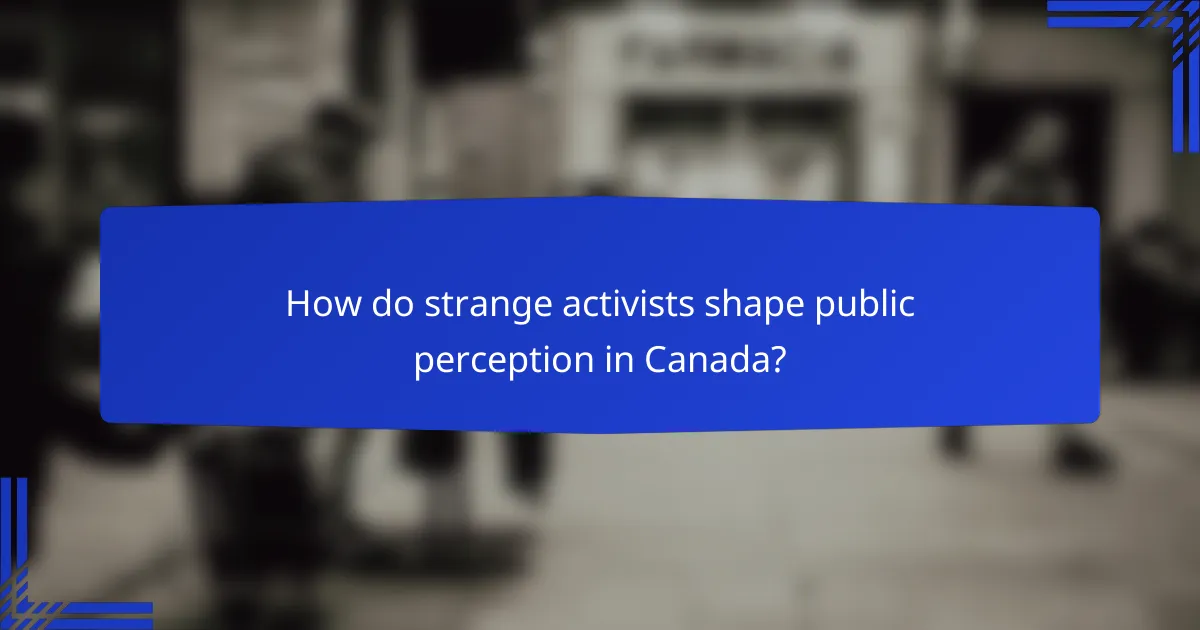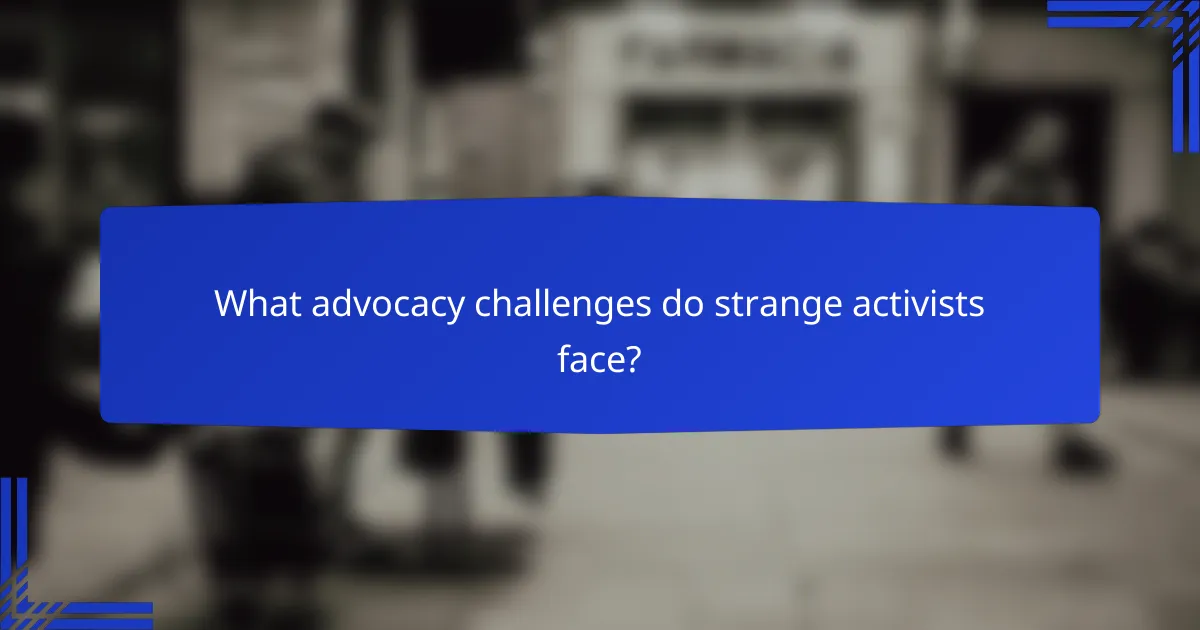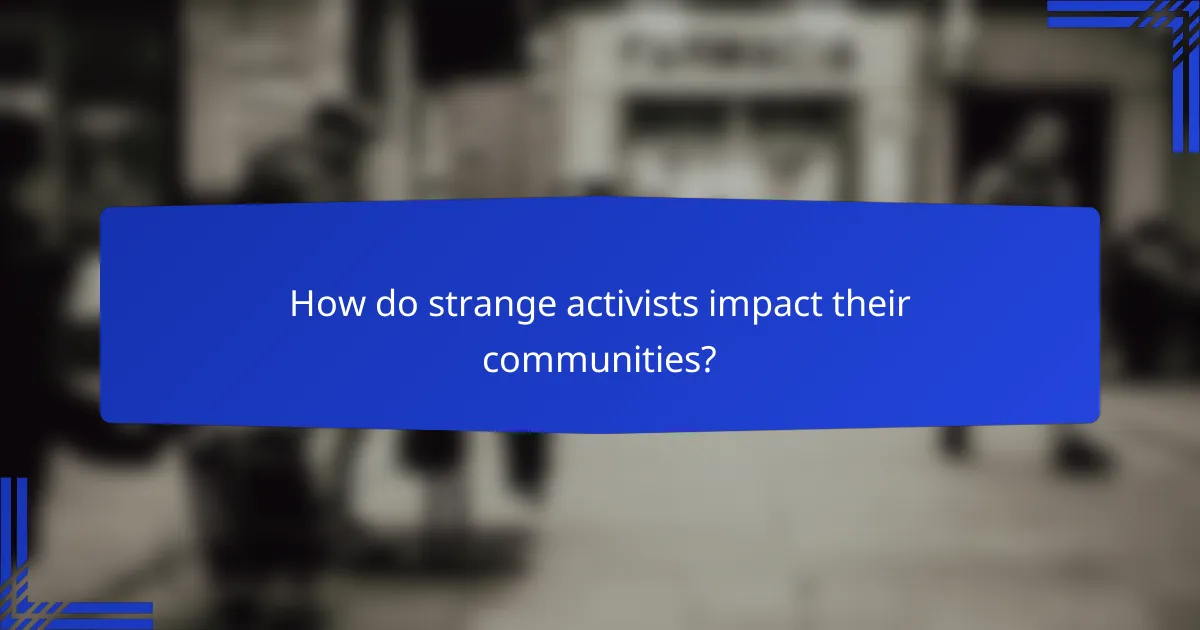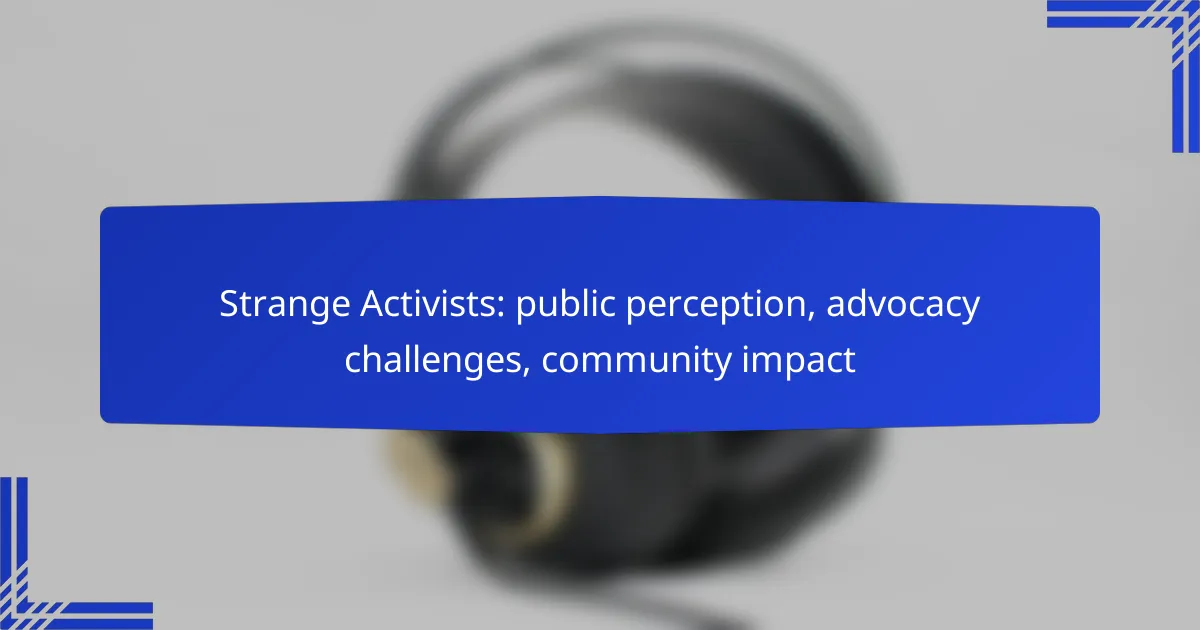Strange activists play a crucial role in reshaping public perception and sparking dialogue around unconventional causes. By challenging societal norms, they not only bring attention to critical issues but also face significant advocacy challenges that can hinder their efforts. Despite these obstacles, their unique approaches can foster community engagement and prompt meaningful action.

How do strange activists shape public perception in Canada?
Strange activists in Canada often challenge conventional views and provoke discussions that reshape public perception. Their unique approaches can draw attention to critical issues, influencing how communities perceive activism and social change.
Influence on media narratives
Strange activists frequently become focal points in media narratives, often portrayed as either heroes or outliers. Their unconventional methods can lead to sensational coverage, which may amplify their messages but also risk misrepresentation. Media outlets may highlight their actions to provoke public interest, thus shaping the overall narrative around specific causes.
This influence can be double-edged; while it raises awareness, it can also polarize public opinion. Activists must navigate this landscape carefully, ensuring their core messages are communicated effectively despite potential media biases.
Public engagement strategies
Strange activists employ a variety of public engagement strategies to connect with diverse audiences. These may include interactive art installations, flash mobs, or social media campaigns that challenge norms and encourage participation. By using unexpected methods, they can capture attention and spark conversations about important issues.
Effective strategies often involve collaboration with local communities, ensuring that the activism resonates on a personal level. Engaging storytelling and relatable content can help bridge gaps between activists and the public, fostering a sense of shared purpose.
Case studies of notable activists
One notable example is the group “Black Lives Matter Canada,” which has utilized unconventional protests to draw attention to systemic racism. Their bold tactics have sparked national conversations and influenced public policy discussions.
Another example is the artist collective “The Yes Men,” known for their satirical interventions that critique corporate practices. Their actions have not only raised awareness but have also led to significant media coverage, illustrating how strange activism can effectively challenge the status quo.

What advocacy challenges do strange activists face?
Strange activists often encounter significant advocacy challenges that hinder their efforts to promote their causes. These challenges include resistance from established organizations, limited funding and resources, and various legal and regulatory hurdles that can impede their initiatives.
Resistance from traditional organizations
Strange activists frequently face pushback from traditional organizations that may view their methods or messages as unconventional. This resistance can manifest in the form of public criticism, lack of collaboration opportunities, or even active opposition. For example, established environmental groups might dismiss radical climate actions as counterproductive, limiting the strange activists’ outreach and support.
To navigate this resistance, strange activists should seek to build coalitions with like-minded groups and articulate their unique perspectives clearly. Engaging in dialogue with traditional organizations can also help bridge gaps and foster mutual understanding.
Funding and resource limitations
Funding is a critical challenge for strange activists, as they often operate outside mainstream channels that attract substantial financial support. Many rely on small donations, crowdfunding, or grants that may not cover their operational needs. This financial strain can limit their capacity to execute campaigns effectively or reach broader audiences.
To overcome funding limitations, strange activists can explore diverse fundraising strategies, such as hosting events, leveraging social media for outreach, and applying for niche grants that align with their specific missions. Building a strong community presence can also enhance their visibility and attract more supporters.
Legal and regulatory hurdles
Strange activists may encounter various legal and regulatory challenges that complicate their advocacy efforts. These can include restrictions on public demonstrations, permits required for events, or compliance with local laws regarding fundraising and activism. Such hurdles can stifle innovative approaches and limit the scope of their actions.
To navigate these legal complexities, strange activists should familiarize themselves with local regulations and seek legal advice when necessary. Understanding the legal landscape can help them plan their activities more effectively and mitigate potential risks associated with non-compliance.

How do strange activists impact their communities?
Strange activists can significantly influence their communities by challenging norms and advocating for unconventional causes. Their unique approaches often draw attention to pressing social issues, fostering dialogue and prompting action among residents.
Community mobilization efforts
Strange activists often excel in mobilizing community members around specific causes. They utilize unconventional methods, such as art installations or performance protests, to engage the public and raise awareness. These efforts can lead to increased participation in local events and initiatives.
For example, a group might organize a quirky parade to highlight environmental issues, attracting diverse participants and media coverage. This type of mobilization can energize community spirit and encourage collective action.
Long-term social change initiatives
Many strange activists focus on creating long-term social change by addressing systemic issues through innovative strategies. They often challenge traditional advocacy methods, seeking to inspire shifts in public perception and policy. This can involve campaigns that blend humor with serious messages to reach broader audiences.
For instance, an activist group might run a series of workshops that combine art and education to tackle social justice themes. Over time, these initiatives can lead to lasting improvements in community attitudes and behaviors.
Collaborations with local organizations
Strange activists frequently collaborate with local organizations to amplify their impact. By partnering with established groups, they can leverage resources and expertise, enhancing the effectiveness of their campaigns. These collaborations can also help bridge gaps between different community sectors.
For example, an activist group might team up with a local non-profit to host a community event that addresses mental health awareness. Such partnerships can create a more inclusive environment and foster a sense of shared purpose among diverse community members.

What frameworks can support strange activists in Canada?
In Canada, frameworks that support strange activists include community networks, legal advocacy groups, and resource-sharing platforms. These frameworks help activists navigate challenges, build coalitions, and amplify their voices within diverse communities.
Coalition-building strategies
Coalition-building is essential for strange activists to create a unified front. This can involve forming alliances with like-minded organizations, engaging in joint campaigns, and sharing resources. For instance, activists can collaborate with environmental groups to address overlapping concerns, thereby increasing their impact.
To build effective coalitions, consider hosting regular meetings to foster communication and trust among members. Establish clear goals and roles within the coalition to ensure everyone is aligned and accountable. Avoid common pitfalls such as lack of transparency or unequal participation, which can undermine coalition efforts.
Effective communication practices
Effective communication is crucial for strange activists to convey their messages clearly and resonate with their audiences. Utilizing social media platforms, blogs, and community events can help activists share their stories and engage with the public. Tailoring messages to specific demographics can enhance outreach and support.
When communicating, prioritize clarity and authenticity. Use visuals and storytelling techniques to make complex issues more relatable. Regularly assess the effectiveness of communication strategies through feedback and engagement metrics to refine approaches and maximize impact.

What are the emerging trends in activism?
Emerging trends in activism reflect a shift towards more inclusive and technology-driven approaches. Activists are increasingly leveraging digital platforms to amplify their voices and connect with diverse communities.
Digital activism and social media
Digital activism utilizes social media platforms to mobilize supporters, share information, and raise awareness about various issues. This form of advocacy allows for rapid dissemination of messages and can reach a global audience almost instantly.
However, the challenge lies in navigating misinformation and ensuring that messages resonate with the intended audience. Activists should focus on creating authentic content and engaging directly with their followers to build trust.
Intersectionality in advocacy
Intersectionality recognizes that individuals experience overlapping social identities, which can affect their access to rights and resources. This trend encourages activists to consider multiple perspectives and address issues like race, gender, and class simultaneously.
By adopting an intersectional approach, movements can create more comprehensive solutions that reflect the needs of diverse groups. Activists should collaborate with various stakeholders to ensure that all voices are heard and represented.
Global influences on local movements
Global influences significantly shape local activism, as movements often draw inspiration from international campaigns. This interconnectedness allows local activists to adopt successful strategies and adapt them to their specific contexts.
However, it is crucial for local movements to maintain their unique identity and address community-specific issues. Activists should balance global trends with local needs to create effective advocacy efforts that resonate with their audience.

How can strange activists enhance their advocacy efforts?
Strange activists can enhance their advocacy efforts by embracing innovative strategies that resonate with broader audiences. By leveraging technology, forming alliances, and exploring creative fundraising, they can amplify their message and increase community impact.
Leveraging technology for outreach
Technology plays a crucial role in enhancing outreach for strange activists. Utilizing social media platforms, websites, and mobile apps can help them connect with a wider audience and share their unique perspectives effectively. For instance, live-streaming events or creating engaging video content can capture attention and foster community engagement.
Additionally, data analytics can provide insights into audience preferences, enabling activists to tailor their messaging. Tools like Google Analytics or social media insights can help identify which content resonates most, allowing for more strategic outreach efforts.
Building alliances with mainstream movements
Forming alliances with mainstream movements can significantly bolster the efforts of strange activists. By collaborating with established organizations, they can gain credibility and access to larger networks. This partnership can also provide resources and expertise that enhance their advocacy initiatives.
To build effective alliances, activists should identify common goals and values with mainstream groups. Joint campaigns, events, or educational initiatives can create a united front, making their message more powerful and appealing to a broader audience.
Innovative fundraising approaches
Strange activists can explore innovative fundraising approaches to support their initiatives. Crowdfunding platforms like Kickstarter or GoFundMe allow them to reach potential supporters who resonate with their cause. By presenting compelling stories and clear goals, they can attract donations from a diverse audience.
Additionally, hosting unique events, such as themed fundraisers or community challenges, can engage local supporters and generate funds. Offering incentives, like exclusive merchandise or experiences, can further motivate contributions and strengthen community ties.
